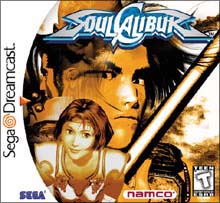
Rewind back to last October when Namco shocked the gaming world by announcing
its full support for Sega's next generation console Dreamcast. At the
time it was unclear what kind of games would be appearing from the powerhouse
developer. Many people assumed it would be some sort of incarnation of
the Tekken series. The cat was let out of the bag a few days before the
Tokyo Game Show Spring 1999 when Namco announced its first Dreamcast offering
would be an arcade port to the sequel of the popular Playstation title
Soul Edge, Soul Calibur. When the doors opened at TGS last March, showgoers
were mesmerised by the then only 30% complete Soul Calibur. It's bright
visuals and ultra-fast gameplay kept players lined up all day to have
a try. Two months later at E3 it was the same story. Attendees were lined
up for hours playing Dreamcast demos side by side with the arcade counterpart.
The comparison blew away everyone. For the first time in gaming history,
the home version outshined the arcade version. Fast forward to August
5th when Soul Calibur arrived in Japan. Did its earlier hype live up to
expectations? Yes and then some.
Namco has once again lived up to its reputation as being one of the premier
publishing houses in the industry. Soul Calibur just screams goodness
over and over. The 3D weapons fighter has made a simple but yet fantastic
port to the Dreamcast. The game plays the same as the arcade counterpart
but also has some distinct features exclusive to the Dreamcast version.
Players can choose between arcade mode or Dreamcast mode. The Dreamcast
mode provides an extra set of moves not found in the arcade version. There
are a total of 19 playable characters, each with their own unique set
of attributes and weapons. Each character within itself provides hours
of enjoyment while players learn to master the intricate combo system.
While the game is quite easy to pick up and play, it is the expert players
who will find most gratification in mastering each character and then
facing off against friends. Simple combos are easily performed however
the more sophisticated combos are performed by linking series of smaller
combos. In some ways this is similar to the combo system first established
by the Killer Instinct series.
While the arcade port itself is simply enough to buy the game, it is the
extras that Namco is renowned for that makes the purchase of Soul Calibur
even more enticing. There are 10 modes to be uncovered including: arcade,
vs., team battle, time attack, survival, extra survival, practice, mission
battle, museum mode and the Japan only internet mode. Those familiar with
Soul Edge's Edge Master mode will be happy to find a similar concept in
the mission mode. The mission mode found in Soul Calibur pits players
against various opponents involving specific tasks. Once your opponent
is defeated you are awarded points. These points are then used to unlock
some of the 338 pieces of art found in the museum. Unlocking various pieces
of art reveals a number of hidden items including hidden stages, characters,
costumes, backgrounds, and weapons.
You have undoubtedly heard and/or seen the raves surrounding the visuals
found in Soul Calibur. Well yes it is true, if you want to impress Dreamcast
naysayers, then Soul Calibur is an early offering to put them to rest.
Namco has utilised the Dreamcast's ability to intelligently light source
many facets of the game. The backgrounds are fully 3D. They are deep and
a visual treat and alternative to the usual 2D uninteractive backgrounds
which plague so many fighting games. The game runs smoothly at a constant
60 FPS. Namco has left no detail untouched. Most noticeable is how the
characters' clothes move in conjunction with real-time movements. Add
to this the detailed facial expressions and lightning speed movements
of the characters and there is nothing to complain about in terms of visuals.
The music and multitude of sound effects are standard Namco brilliance.
The only complaint is the famous Namco FMV is missing from Soul Calibur.
As minor as it is, it would have been the icing on the cake to provide
unique FMV to each of the characters' endings.
Final Word
 What else do you need to know? Nothing! The only other fighting game that
looks to challenge Soul Calibur anytime soon is Dead Or Alive 2, which
at this point in time is not even out in the Japanese arcades. If you
enjoy fighting games, Soul Calibur is the definitive Dreamcast fighting
game to have at launch and beyond. Its intoxicating mix of visuals and
depth of play will keep players coming back for more and more in months
to come.
What else do you need to know? Nothing! The only other fighting game that
looks to challenge Soul Calibur anytime soon is Dead Or Alive 2, which
at this point in time is not even out in the Japanese arcades. If you
enjoy fighting games, Soul Calibur is the definitive Dreamcast fighting
game to have at launch and beyond. Its intoxicating mix of visuals and
depth of play will keep players coming back for more and more in months
to come.
Review By: Micheal Weatherup |